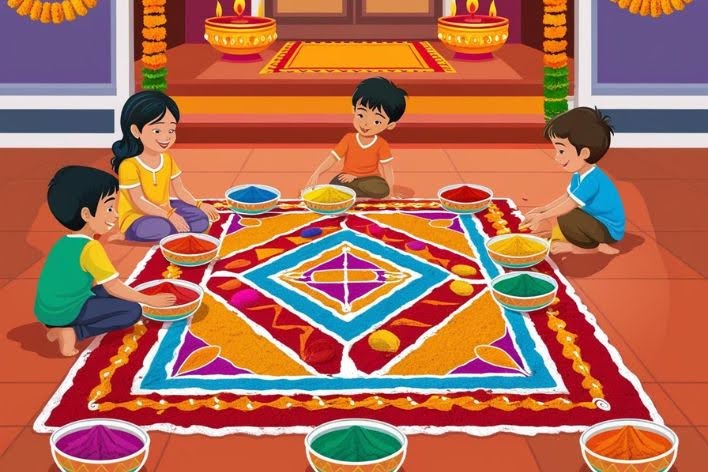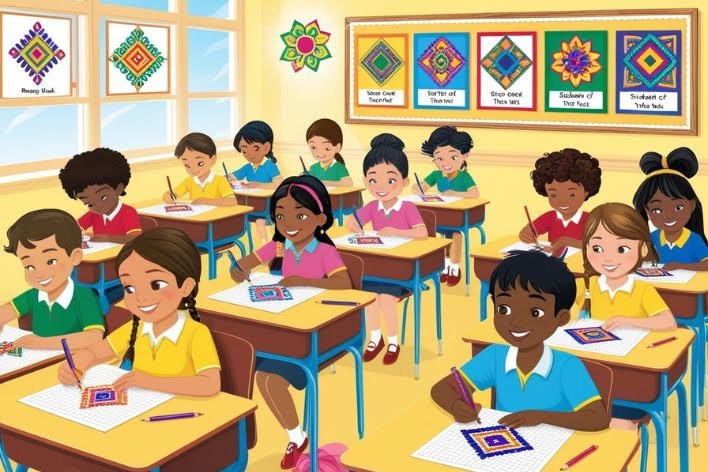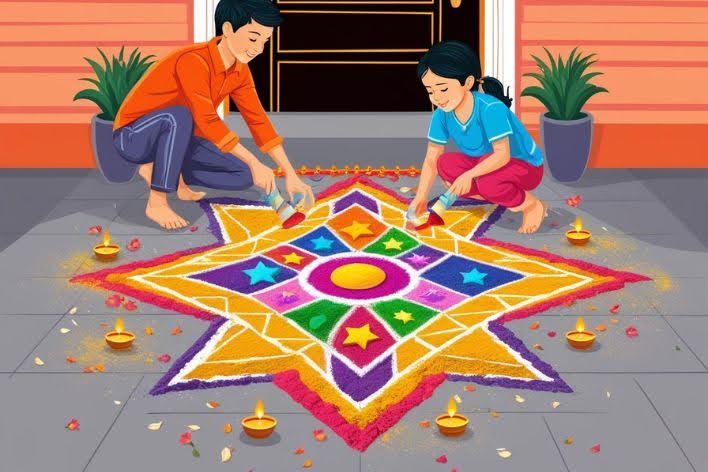Rangoli with Geometrical Shapes
Introduction
Geometrical Shape Rangoli is not just a vibrant floor pattern—a splash of color, culture, and education. For kids specifically, making simple rangoli using geometric shapes can be an exciting thing to do, stimulating creativity and understanding of basic shapes. Through the use of uncomplicated designs made of geometric rangoli shapes like circles, squares, and triangles, kids can learn to create symmetric, colorful masterpieces while linking them to their own cultural heritage.
Repeating the process of making rangoli with geometric shapes also introduces mindfulness. The repetition of drawing motives soothes children, makes them focus, and teaches them to live in the moment. The good news? It doesn't require complicated methods. Beginners can still experiment with geometric rangoli patterns and transform dreary spaces into cheerful art galleries.
Diwali, Pongal, or any other festive day, rangoli motifs with geometric figures make it easy and enjoyable to decorate any setting. And most importantly, above all that, easy rangoli with geometrical shapes for kids is for all ages, encouraging family connection and cultural narrative through vibrant images. It’s also perfect for rangoli with shapes for kids projects in schools or homes.
Understanding Rangoli and Why It is Important
What is Rangoli?

Rangoli is an Indian folk art in which vibrant colors are employed in order to form a detailed pattern on the floor with colored powders, flower petals, or rice. The term comes from Sanskrit and refers to "row of colors." Designs can be complex or simple, and some of the older designs are done using geometrical shapes.
With geometrical shapes and rangoli, children and beginners can simplify the art. Not only is the art beautiful but it also carries symbolic meaning. Circles can represent oneness, triangles represent strength, and squares represent stability. These elementary forms are the basis of geometric rangoli designs.
Creating easy rangoli with geometrical shapes for kids makes children participants in culture while learning hand-eye coordination, spatial perception, and creativity. It also helps introduce mathematical rangoli with concepts such as symmetry, angles, and proportionality—perfect for early learners.
Cultural Significance
No Indian celebration is ever complete without Rangoli—with vibrant patterns and designs often featuring easy rangoli with geometrical shapes—adorning entrances, courtyards, or front yards. It signifies happiness, positive energy, and a warm welcome to gods and visitors alike.
Through colorful representations of symmetry, these designs of geometric rangolis retain heritage while keeping kids involved with tradition. Many families encourage rangoli with 5 geometrical shapes to teach children about pattern formation and cultural storytelling.
Step-by-Step Guide to Making Your First Geometrical Rangoli

Step 1: Get Ready to Create Your Grid
Begin with a grid made of 7 x 7 dots, i.e. seven dots lying horizontally and seven dots standing vertically.
Step 2: Drawing Of Standard Figures
Now begin to draw circles, squares, and triangles from the dots as guides. These are the building blocks for your geometric rangoli designs.
Step 3: Combine Shapes
Mix the shapes creatively. Overlap a triangle inside a circle, or place a square between two triangles. You’ll notice beautiful symmetrical patterns forming—this is the essence of rangoli using shapes.
Step 4: Add Colour
Use vibrant Rangoli powders to fill in the shapes. Choose bright and contrasting colours for visual appeal. This is the fun part of easy rangoli with geometrical shapes—let kids choose their favorite colors!
Step 5: Mark Your Edges
Ensure lines and edges are clean. This provides neatness to your geometric rangoli and an improved finish.
Step 6: Check Composition
Before you complete your easy Rangoli with geometrical shapes, step back and check the overall balance—are all sides even, and does the pattern look finished and pleasing?
Step 7: Obey Your Shapes
Here's an exercise you can try:
By using circles, squares, and triangles, make a design using 7 × 7 dots and colour your design. Also, Count the number of circles, squares and triangles in your rangoli.
Example Answer:
-
Number of circles = 4
-
Number of squares = 6
-
Number of triangles = 4
This is a simple and fun mathematical rangoli with concepts kids can enjoy in classrooms or at home.
Why Geometric Shapes Are Suitable for Creating Rangoli
-
Geometrical rangoli patterns are easy to replicate and understand.
-
Kids can identify and outline circles, triangles, and squares without complex training.
-
These patterns improve symmetry, which is a primary quality art rule.
-
Children improve their focus, finger control, and color coordination as they master drawing rangoli using shapes.
-
They're adaptable for any occasion—Diwali, birthdays, school parties—making them a convenient yet stunning choice.
The elegance of Rangoli through Geometric Shapes lies in its simplicity and sophistication. These patterns never intimidate children; they encourage imagination, logical arrangement, and strong presentation. That’s why rangoli with 5 geometrical shapes remains a popular choice in school art lessons and festival prep.
Tips for Choosing the Right Geometric Shapes for Your Rangoli Design
-
Start simple: Squares, triangles, and circles are easy and basic.
-
Utilize combinations: Couple circles and triangles for contrasting effects.
-
Match the occasion: Use glowing circles for Diwali; design triangles for kite festivals.
-
Be symmetrical: Balance adds to the visual appeal of rangoli using shapes.
-
Choose your colors wisely: Contrast enhances the design.
-
Avoid clutter: Balance your use of rangoli with 5 geometrical shapes to keep the design clean.
Fun Variations to Try with Geometric Shapes in Rangoli
Once you're comfortable with easy Rangoli with geometrical shapes for kids, challenge yourself with these creative variations:
Concentric Shapes: Design alternating circles or squares that expand outward.
Star Patterns: Use overlapping triangles to form star patterns.
Animal and Flower Shapes: Begin with basic rangoli using shapes, then decorate with lines and dots.
Colour Play: Create checkerboard patterns with color swaps.
Stencils: Use cardboard cutouts to help younger children trace clean shapes.
Educational Benefits of Rangoli with Geometrical Shapes
Rangoli isn’t just artwork—it’s a coaching device. When children interact with smooth rangoli with geometrical shapes, they’re exploring greater than creativity. They advantage:
Cognitive development: Recognizing styles and knowledge symmetry boosts spatial intelligence.
Math integration: Concepts which include rotation, reflection, fractions, and counting become part of play.
Cultural consciousness: Children get to discover the “why” behind traditions like Diwali and Pongal, studying about Indian heritage.
Fine motor capabilities: Coloring inside shapes, outlining designs, and putting powders assist in finger muscle development.
This makes geometric rangoli an excellent pass-disciplinary activity, integrating artwork, math, culture, and mindfulness.
Integrating Rangoli into School Curriculum
Teachers can use geometric rangoli designs as a weekly or month-to-month venture. Suggested thoughts:
Math + Art Class Crossover: Use graph paper to devise rangoli, reinforcing grid understanding.
Holiday Themed Projects: Have college students create themed rangoli the usage of shapes for Independence Day, Environment Day, or Children's Day.
Language Learning: Have students write some sentences describing their design and the quantity of each form used.
This now not most effective builds visible studying however additionally reinforces vocabulary, common sense, and cultural education.
Rangoli Across Indian States – A Cultural Tour
Though Rangoli is not unusual throughout India, the call and designs range by using nation. Introduce youngsters to:
Alpana (West Bengal): Often round and floral.
Kolam (Tamil Nadu): Uses dots and features, wonderful for coaching symmetry.
Mandana (Rajasthan): Features immediately lines and triangles—brilliant for geometry!
Chowk Purna (Uttar Pradesh): Uses rice paste and symmetrical paperwork.
You can encourage a “state-smart rangoli” day in school, allowing children to create and explain patterns stimulated with the aid of specific Indian traditions.
Using Technology for Rangoli Learning
Drawing Apps: Programs like Tux Paint or MS Paint can simulate geometric rangoli.
Projection Tools: Teachers can challenge traditional rangoli photographs and have students become aware of shapes.
Augmented Reality: New AR tools let children overlay rangoli styles on actual areas for exercise earlier than the use of powders.
This makes even the messier factors of rangoli attainable in digital-first lecture rooms or small domestic areas.
Hosting a Rangoli Day
Schools or groups can prepare a “Rangoli Day” with stations providing:
Freehand Rangoli Corner : Encourage loose drawing the usage of shape cutouts
Math Rangoli Zone : Kids solve shape-primarily based puzzles and create a layout using the answers
Color Splash Arena : A colour mixing station teaches approximately complementary hues
Storytelling Wall: Each baby writes a brief tale about their rangoli pattern
The Science Behind Geometrical Shapes in Rangoli Geometrical shapes
Play a giant position inside the logical and cognitive development of children. When integrated into rangoli designs, they provide tons greater than aesthetic fee:
-
Spatial Intelligence: Children learn about space and item placement.
-
Visual Processing: Recognizing and replicating shapes improves visible memory.
-
Pattern Recognition: This is a foundational ability in both math and studying.
How to Organize a Rangoli Workshop for Kids
Planning a rangoli occasion or workshop can convey children, teachers, and dad and mom collectively. Here is a step-by means of-step plan:
Theme Selection: Choose a baby-friendly subject together with nature, animals, or fairs.
Material Prep: Provide templates, chalk, powdered colours, and stencils.
Tutorial Session: Start with a quick demo on a way to make a fundamental geometric rangoli.
Guided Activity: Allow kids to copy the demo before allowing them to design their very own.
Exhibition: Showcase the youngsters’s artwork and encourage peer remarks.
Simple Projects to Enhance Creativity
Color Mixing Exercise: Let youngsters combo primary hues to create specific patterns.
Shape Hunt: Children discover actual-existence gadgets that match rangoli shapes earlier than growing a design.
Seasonal Rangoli: Make designs based totally on monsoon, wintry weather, spring, and summer time issues.
Using Natural and Sustainable Materials in Rangoli To make rangoli activities extra eco-friendly, children can use:
-
Flower petals (marigold, rose, jasmine)
-
Turmeric and kumkum
-
Colored rice
-
Natural chalks
-
Sand and lentils
Parental Involvement in Geometric Rangoli Projects Parents can:
-
Design rangoli together with youngsters on weekends
-
Use it as a no-screen family interest
-
Share children’s designs on-line or with spouse and children
Printable Rangoli Templates for Beginners Offering downloadable templates of:
-
Triangle-based superstar patterns
-
Square spirals
-
Circle mandalas
Digital Rangoli Making Apps and Games Some baby-friendly virtual systems encompass:
-
Rangoli Design App for Kids
-
Mandala Coloring Book
-
Color-by means of-Shape mobile games
These tools help youngsters visualize thoughts earlier than physical execution.
How Teachers Are Using Rangoli in Online Learning Virtual school rooms now host:
-
Rangoli design competitions via Zoom
-
Shape identification duties with digital drawing equipment
-
Virtual gallery walks
How Rangoli Boosts Emotional Wellbeing Coloring and growing shapes activates calming brain functions. It can:
-
Reduce tension
-
Improve consciousness
-
Enhance vanity
Real-Life Examples and Practice Ideas
Classroom Rangoli Art Assignments

In Hyderabad, Spring Blossom School uses mathematical rangoli with concepts in weekly lessons. Children create rangoli with shapes for kids challenges, like “Triangles Only,” then transfer those ideas to graph paper.
Festival Home Decorating

The Joshi family in Pune uses chalk and rangoli powder to create rangoli with 5 geometrical shapes. Each child selects different shapes yearly, enhancing family bonding and creativity.
School Competitions

Delhi Public School, Bengaluru, includes “Geometry in Art” in its Republic Day competition. Kids apply mathematical rangoli with concepts like symmetry and proportion in their entries.
Online Challenges

In Mumbai, parents launched a WhatsApp challenge where children shared their weekly easy rangoli with geometrical shapes for kids. Topics like “Only Circles” or “Mixed Shapes” inspired creativity and online sharing.
Social Media Galas for Encouragement

Instagram pages like @littleartstarsindia often feature rangoli with shapes for kids. Posts with geometrical animals or flowers bring attention and confidence to young artists.
Things You Learn
-
Geometrical Shapes Rangoli is a timeless activity mixing culture with creativity.
-
Whether it's rangoli using shapes at home or teaching kids during school art time, the fun lies in arranging basic forms with colors.
-
Kids build pride in tradition, develop fine motor skills, and learn visual math through mathematical rangoli with concepts.
-
From simple dots to beautiful symmetry, each step in easy rangoli with geometrical shapes for kids is both joyful and educational.
-
Easy Rangoli with geometrical shapes, with its endless design possibilities, is sure to become a favorite activity for everyone—kids, teachers, and parents alike.
FAQs
How to draw rangoli using geometrical shapes?
Begin with placing dots in a grid form, then join them using circles, squares, and triangles. Add colors to form a balanced, symmetrical rangoli using shapes.
What are rangoli shapes?
Shapes like circles, squares, triangles, stars, and hexagons form the basics of rangoli with 5 geometrical shapes.
What is a mathematical rangoli?
A mathematical rangoli with concepts includes symmetry, patterns, and spatial understanding. It teaches geometry in a creative way.
What is kolam shape in maths?
Kolam shapes use curves and symmetry based on dot grids. They’re a form of mathematical rangoli rooted in tradition and logic.











